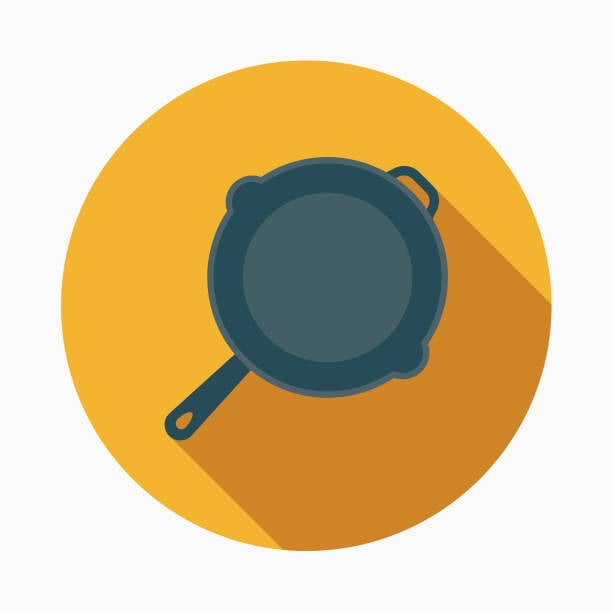Nice work! Cast iron truly is the opposite of planned obsolescence.
There’s a reason they started selling pans where a single scratch makes people replace them…
A lodge would last a century, probably longer unless you stored it in salt water.
Ironically the only reason Lodge can be as big as they are today, is most people don’t have a cast iron pan.
I got a big one and a small one. They’re awesome and highly recommended, but I’ll never ever need to buy from that company again now.
See that was my thought as well. The problem is they’re addicting. Idk why or how but I now have 6 cast iron pans, two Dutch ovens, and a carbon steel wok.
Sounds like you might need a small carbon steel pan such as is popular in restaurants. The best for eggs.
Bruh, I ran out of space in the kitchen and ended up with a 36" Blackstone out back. Addictive is right!
I’m eyeing the deep 12" Lodge now but would likely have to give up an older 12 to make space.
What does that process look like to turn it from that into this
The majority of the black crusty crap on the pan was ages-old layers of carbonized oil. Likely the customer was using a poor oil choice for higher temperature frying and cooking, like EVOO, which would cause more and more layers to build up over time.
I got a large 44gal tote and filled it about to where it could cover the pans, then added sodium hydroxide crystals to it. Exact measurements vary on quantity of water, ambient temperature, length of soaking, etc. NEVER ADD WATER TO SALT, start with water then salt after.
The lye bath got rid of the majority of the gunk, and using a wire scouring wheel on an electric drill (WITH GOGGLES ON) finished the job.
Following this, I seasoned with two layers of homemade ghee.
Not OP but when my pans got shitted up like this by crappy roommates I put the pans in the oven on the clean function. All the crud was carbonized. I then wiped off the ash, seasoned them with shortening, and baked them for a bit. You have to touch up the dry areas for a bit after with more oil but eventually the pan ends up properly seasoned with use
Pro tip: do this in the winter so you don’t make your house 100 degrees in the summer
You should never use the clean function on the oven, even for cleaning the oven. It can severely limit the lifespan of the oven as well as cause other issues (especially if you have birds or other small animals).
Another problem with using it for “cleaning” CI is especially on more delicate, thinner casts like old Wagner, CHF, etc, it can cause severe warping of the iron.
I was unaware. Good to know
The good news is I’ve taken care of my pans since and as we all know: a long as you’re not a total dingus, you’re not likely to screw your pans up a bad as OPs.
Especially curious about the initial step of getting rid of all the built-up crud
I’m guessing a lot of wire wheeling to remove the cracked surface, and then reseasoning the entire pan, but idk for sure
First you remove the old seasoning using one of a few methods. That leaves you with bare iron. Then you re-season.
My preferred way to strip a pan of its old seasoning is to heat the pan up to 200F in the oven, then take it outside and spray it with oven cleaner. Then I put it in a trash bag and bring it inside (or leave it outside if it’s summer) and let the oven cleaner do its thing. Rinse and repeat until there is no more seasoning. Wear protective equipment, of course.
Other methods include an electrolysis bath, or using the self-clean cycle on your oven (It’s possible to damage the pan this way, but chances are it’ll be fine).
To re-season, I like to use Crisco.
- Warm the pan to 200F in the oven
- Remove and apply a coat of Crisco. Be thorough.
- Remove excess so you have only a very thin coat of oil
- Bring the pan to 300F in the oven for 15 or so minutes
- Remove and give the pan an additional wipe down of any excess oil that might have pooled during the 300F cycle
- Bake upside down at ~460F (some people do 475F) for 2 hours. The smoking point is above 500F so we leave it just below that to polymerize.
- Turn oven off, but leave the pan in while the oven cools down (takes hours).
I do that cycle once a day until the pan looks good. It takes anywhere from 4 to 80 coats. Just kidding about 80, but someone on reddit did that.
The pan will NOT be shiny after seasoning. Seasoning is a permanent layer of polymerized oil. You still need to cook with your favorite cooking oil, which will make the pan shiny.
Washing the pan with soap will leave it looking dull again, because you’ve washed away the cooking oil. The seasoning will still be intact unless you’ve destroyed it some other way (tomatoes are acidic and can wear down the seasoning, putting it in the dishwasher will destroy the seasoning, etc.)
Funny, I actually go over the smoke point to polymerize. I use ghee and cook at 525 for 1 hour, repeating the process for additional layers. It makes beautifully smooth and hard finishes.
Literature on the subject has been highly contradictory in my experience. Some argue that the oil or fat should be below smoke point, and others say it should be over. I personally avoid Crisco, vegetable oil and seed oils in my cooking and I extend that to seasoning as well.
Ghee has worked fantastically for me but it’s another case of he-said-she-said, with half the internet thinking it is the perfect cooking and seasoning fat, and the other half decrying it for a higher rate of spoiled or rancid seasoning — issues I’ve personally yet to come across. Everyone’s mileage varies so much with cast iron, doesn’t it?
A true seasoned surface will only form properly at temperatures well in excess of the 350-375 degree F temperature that some manufacturers recommend for seasoning cast iron. Low temperatures do not completely polymerize and break down oil and will leave a brown, somewhat sticky pan instead of a black, non-stick one. 400-500 degrees F is the effective range for seasoning.
From Dave Arnold’s excellent blog ‘Cooking Issues’
https://cookingissues.com/2010/02/16/heavy-metal-the-science-of-cast-iron-cooking/
I always thought you were supposed to go over the smoke point, but I did a bit of reading recently and found one source that sounded confident that staying below the smoke point still results in polymerization. There was also conflicting information on the actual smoke point of shortening, anywhere from 490-525F. So far 470 is working well, but whether the seasoning is durable long term is yet to be seen.
There’s still a “smoking oil” smell in the kitchen so I leave the fan running, but there’s no visible smoke. I think with the oven set to 470F, there’s probably enough radiant heat from the oven coils to bring the iron up to 490+, at least for a little bit. That’s just an unscientific guess, though.
I only saw the top half of the pic before scrolling down, and didn’t realize it was just part of a “before and after” comparison. My initial thought was “uh, I’m not going to post any rude comments, but that pan looks like sh… OH WAIT A MINUTE!”
Thanks for the chuckle! I can’t imagine how little self awareness or sense of shame I would need to post only the top photo and pretend it was anything more than destined for the trash xD


